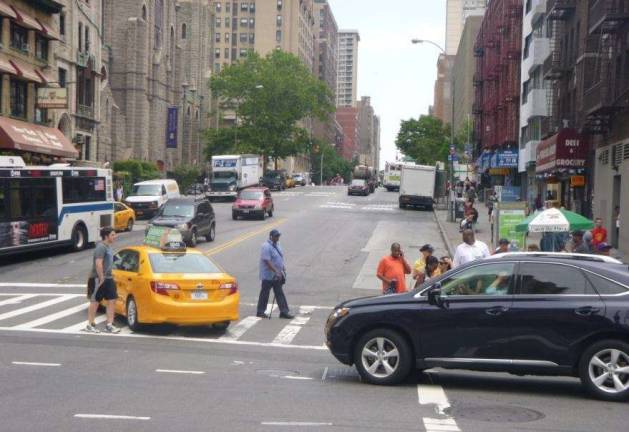Cross Examination

A community board study looks to improve pedestrian safety on the Upper West Side A pedestrian safety study initiated by Community Board 7 could soon result in a raft of pedestrian-friendly changes this fall for those who walk the neighborhood from 94th to 96th Street. "One of the driving purposes of [the study] is to provide safety for folks moving around," said CB7 Chairman Mark Diller. "Public transit, pedestrians, and all the other modes of transportation that go through that." Diller said the initial idea to conduct a study was "serially refined" to a manageable scale; 94th to 96th Street between Central Park and the Hudson River. Why this area in particular? One issue is cars speeding in and around the corridor between Columbus and Amsterdam Avenues on 97th Street, according to Diller, which is home to at least eight schools. "It's not surprising that there are pedestrian, and especially young-people pedestrian, safety issues that inform everything that we're looking at there," said Diller. Another trouble spot is the traffic coming off of the highway at 95th Street and heading to the highway at 96th Street. "These are folks that are in a hurry and often frustrated," said Diller. "They create and present all sorts of problems for children, seniors, and virtually anybody else trying to walk across the street." The final example Diller gave, among others in the study, are cars and trucks exiting Central Park at 97th Street and entering the park at 96th Street. "They have issues, not the least of which is a big, fat, wide, flat road between Central Park West and Columbus on 97th Street which is just an invitation, like an engraved invitation, to speed or drive irresponsibly," said Diller. "And what does that do? It funnels you right into a narrower street of 97th between Columbus and Amsterdam which takes you right past all those schools." CB7 conducted its own pilot study with a literature review and input from the community on which intersections and streets were the most dangerous. They then pitched the need for an actual study and received funding from Council Members Gale Brewer, Inez Dickens and Melissa Mark-Viverito. The transportation consulting firm Nelson-Nygaard honed in on the area between 94th and 96th Street, and will bring their recommendations to the board's transportation committee at its Sept. 24 meeting. In the meantime, CB7 and the transportation committee will conduct site visits in the morning and afternoon of the week of Sept. 16. "Pedestrian safety is a constant question," said Upper West Side Council Member Gale Brewer. "These streets, particularly around Broadway and West End Avenue, were the source of many, many phone calls, and emails and letters because people think it's dangerous, and it is." Nelson-Nygaard's pedestrian safety study is not the first that has been conducted on the Upper West Side, but Brewer, Diller and others are hopeful that it will bring about much-needed change. Brewer said suggestions from a much larger and federally funded study that looked at pedestrian safety issues from 56th to 86th Street on the Upper West Side are currently being implemented and that the formula for bringing about these types of changes works. A draft copy of Nelson-Nygaard's study recommends various solutions - from curb extensions and pedestrian islands to increased signage and bus re-routing - to combat dangerous conditions for pedestrians. It notes that West 97th Street from Central Park West to Columbus Avenue - the same area Diller said carries an engraved invitation to speed - is a through route for vehicles traveling across Central Park to the Henry Hudson Parkway. The remedy? Offset curb extensions that double as public space and median islands to prevent drivers from swerving into an adjacent lane to avoid slowing down. The report suggests using the curb extensions for public seating and shade, gardens and bioswales for rainwater runoff management, or installing planters. As for funding, Brewer said she doesn't anticipate having to find and secure the money for pedestrian safety upgrades in the city's budget. "My experience with transportation changes, you don't need a lot of money," said Brewer. "[The Dept. of Transportation] has the money to take care of transportation changes." CB7's transportation committee will decide on priorities at their Sept. 24 meeting with input from Nelson-Nygaard, after which their recommendations will be brought to the full board. Brewer said she wouldn't be surprised if implementation of the safety upgrades goes into 2014, but that she'd like to see them begin sometime in October or November. "This is not the first time this area has been studied, yet the issues persist," said Diller. "The problems are not new, the solutions are incremental, and we're trying to move the ball forward a little bit." CB7 is continuing to solicit input from the public with an interactive comment map on their website, www.nyc.gov/mcb7.